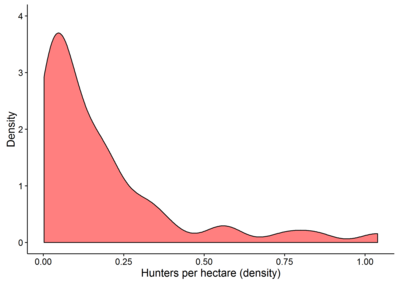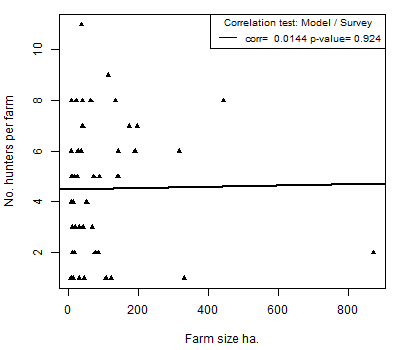A survey was conducted in September 2014 among Danish goose hunters . It asked two questions relevant for the development of the model. These were:
Invitation letters were sent to 1998 goose hunters, throughout Denmark, to participate and complete a questionnaire using the on-line survey tool, SurveyXact. Consent to participate was voluntary and was obtained by email. Participants were advised of the nature of the study and given written details of questions to be asked prior to interviews. All participants gave written informed consent to take part in the study. Anonymity and confidentiality of the interviews were guaranteed to all participants. 962 goose hunters responded (48% response rate), completing the survey. Of the 962 survey respondents 186 were identified as having shot geese in the municipalities of Jammerbugt or Thisted (the two municipalities straddling the Vejlerne model area).
Question 1 was used to assess model distance outputs of hunting locations allocated to hunters.
Question 2 was used as the source data for the decision rule. It enabled hunters to have multiple hunting using the survey frequency distribution to determine how many hunting locations hunters could be allocated.
Figure 2. Number of goose hunting areas with access to. Frequency distribution for survey respondents who shot geese in Jammerbugt or Thisted (n = 186).

In February 2015 a survey was conducted amongst landowners who had farms located within the Vejlerne model area. Of the 558 known farms in the area, invitation letters were sent to 422 manually identified addresses. Recipients were invited to participate and complete an online questionnaire, using SurveyXact. Consent to participate was voluntary and was obtained by email. Participants were advised of the nature of the study and given written details of questions to be asked prior to interviews. All participants gave written informed consent to take part in the study. Anonymity and confidentiality of the interviews were guaranteed to all participants. 84 landowners responded (20% response rate), completing various questions about the presence of geese and goose hunting on their land during the 2014-15 hunting season. We excluded 8 respondents as their farm sizes were less than 5 hectares. The answers given by 76 respondents to 3 questions were pertinent for our model.
All most all respondents (93%, n = 71) stated that geese had visited their land in the past
Question 3 was completed by 47 respondents, who indicated that one or more hunters used their farm for goose hunting during the 2014-15 hunting season. This question was used to assess model hunter density outputs. Total farm sizes were known for each respondent and this data was used to calculate a density distribution, hunters per hectare.
Figure 3. Hunters per hectare density distribution for 47 survey respondents, stating they had one or more goose hunters during the hunting season 2014/15.

It was initially assumed that the larger the farm the more hunters it would accommodate. However, analysis of the relationship between number of hunters per farm and farm size showed no correlation amongst the 47 respondents indicating they had one or more hunters on their farm.
Figure 4. Plot of farm size and number of hunters per farm for 47 survey respondents, stating they had one or more goose hunters during the hunting season 2014-15.

Question 3 was also used to further assess model outputs, using data for number of hunters per farm. In addition, to the 47 respondents indicating they had goose hunters on their land, a further 19 respondents indicated that they had zero goose hunters on their farms; either they had no geese visiting or currently no goose hunting. The data from these 66 respondents was used to derive a frequency distribution for the number of hunters per farm.
Figure 5. Number of hunters per farm for 66 survey respondents, who indicated had zero hunters (either no geese or currently no goose hunting on their farms), or one or more for goose hunting during the hunting season 2014-15.
